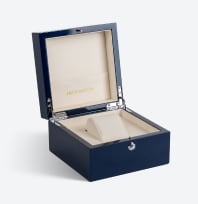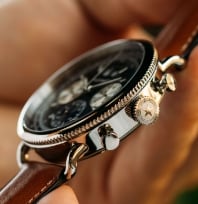Why You Might Want to Replace Your Band
When initially breaking into watches, you will typically try to find faces and bands that work together, pieces that look beautiful as a whole. But the day will come sooner rather than later where you find a face that captivates you, but when you see the band, you find that it doesn't work as a whole or doesn't fit your style.
Like most things in fashion, there are many factors to consider when looking at watch straps. Maybe you don't like the leather that the watchmaker originally chose, maybe you want to have a stainless-steel bracelet for a little bit of added durability, or maybe you just don't like the feel of the strap on your wrist. Whatever the reason is, you're looking to change things up.
But watches are expensive items, and it can be a little scary to make changes, especially if this is your first time swapping a band. But don't worry! Watch bands are much easier to replace than you might initially expect.
In this guide, we'll go over the tools you'll need and provide you with a few easy techniques so that you can upgrade your watch band to be in line with your style.
Tools of the Trade for Changing Your Watch Band
Here's a quick list of everything you'll need to get you started:
- The original watch with strap attached
- The strap you'd like to use as a replacement
- A spring bar tool or a dull knife
If you don't own a spring bar tool, don't worry. Using a dull knife can be just as effective. There are some guides out there that recommend using a sharp knife, but a sharper blade doesn't really add any tangible value, and you don’t want to damage your best kitchen knife.
All that said, although a dull knife can get the job done, we would still recommend purchasing a spring bar tool. They're relatively inexpensive, and they will ensure that you have the easiest experience in taking off and replacing your strap.
Step 1: Check the Strap Size
This may seem obvious to some, but differing watch strap sizes are an issue that is frequently overlooked by newcomers to the hobby. Fortunately, it's easy to check!
Use a ruler, or a pair of calipers if you want to be even more precise, and measure the distance between the lugs. The lugs are the two bits of metal that stick out from the watch case and hold the spring bar in place. The spring bars are the little bars that hold your watch strap in place. The space between the lugs is commonly referred to as lug width.
Lug width is almost always measured in millimeters and on most watches is normally within the range of 18-26 millimeters. Watch straps themselves typically come in even sizes, with 18 mm, 20 mm, and 22 mm being the most common sizes. If you're not sure what size straps you had on before, some brands will have their size written on the straps themselves.
Another easy way is to just look up the watch online. Most retailers nowadays have all the information you might need on their websites. Either way, the most important thing is to get a watch strap that fits your lug width.
Step 2: Taking Off the Old Strap
Turn your watch so that it is face-side down on a soft, flat surface; anything from carpet to a mousepad can work here. The main idea is just to set it on a material that won't be able to scratch or damage it. Next, check the band and identify the spring bar type. There are two kinds.
Quick Release Spring Bar
If you have a newer watch, it may have a quick-release spring bar. You can identify this by seeing if there's a small piece of metal sticking out from the spring bar, the part of the strap nearest the watch face. If there is one, simply pull the metal tab that's poking out towards the middle of the strap. At this point, the strap should disconnect from the face.
Traditional Spring Bar
If you do not have a quick-release spring bar, you'll need to begin by placing your spring bar tool on the space between the strap and the lug. There's typically a small ridge on the right side of the band. You can feel it if you run your finger along the bar. That's the specific point where you'll want to be applying said pressure.
Push down on that ridge and then, while applying downward pressure, push in towards the middle of the bar. This should cause one end of the bar to come off the lug. Typically, once one side of the bar comes off, the other can simply be pulled from the other lug with your fingers.
Your old strap should now be removed!
Step 3: Reinserting the Spring Bars
Once you've gotten your strap away from the main face, pull out the spring bar from the strap. This can be done with your fingers. Now, take the spring bars you just removed and, using your fingers, push them through the holes in the new strap until the bars are poking out on either side of the strap.
If the spring bars you're replacing are of the quick release variant, just push down on the metal tab and then insert into the strap, making sure that the metal tab is sticking up on the side where their hole will be located.
Step 4: Replacing the Strap
Take your new strap and, using your hand, push one side of the spring bar that's poking out into the lug. Then take the forked end of your spring bar tool and push down on the other end of the spring bar so that it lays flush with the strap.
Carefully maneuver the bar so that it lines up with the lug and, once you pull the tool away, it should snap into place. Voila! You have successfully replaced your watch strap.
How to Replace a Metal Band
If the band that you'd like to replace is a metal watch band, instead of a leather strap, this can add some additional steps. First off, check and see if it has a typical spring bar attaching it to the lugs. If you don't see any holes on the exterior, then you can just follow the guide above! If you see that there are little holes, that means the spring bar is attached with small screws instead of the traditional spring bar. Don't worry; this is a fairly simple process!
The first thing you're going to need is to get a screwdriver. It's going to need to be fairly slim, as the holes in these kinds of bands are often very small. Insert the screwdriver into the hole and turn until the screw comes out. Afterward, simply turn the watch over and give it a tap. The screw should fall right out. Now you can pull the spring bar out as we did before.
Grab the new metal strap that you'll be using to replace the old one, and thread the spring bar into the hole at either end so that the bars are sticking out a bit. Place these back into the lugs and, once they click in, simply screw the pieces back in.
Go to a Watch Store
At the end of the day, if you don't feel confident about replacing the straps yourself, or if you feel like it'll be too much of a hassle, you can always go to a watch store. Look online, check their reviews, and find a shop that does quality work. Changing a strap doesn't take much time at all, and the employees in these stores can often change a strap in just a few minutes. Just bring in the watch and the new strap you'd like to put on it, and they should be able to put it on in no time.
Enjoy the Process
The important thing is to just remember to take your time. The process is relatively simple and, with the right tools, can only take a couple of minutes. Knowing how to change your watch strap can be a useful skill to have and can help deepen your bond with your watch. As long as you keep track of all the components while taking them out, know the location of your spring bar, and have the right tools, you should be able to have that new band on in no time!
Sources:
These Are the Best Tools for Changing Your Watch Strap | Gear Patrol
How to Change a Watch Strap without a Trip to the Jeweler | Gear Patrol












